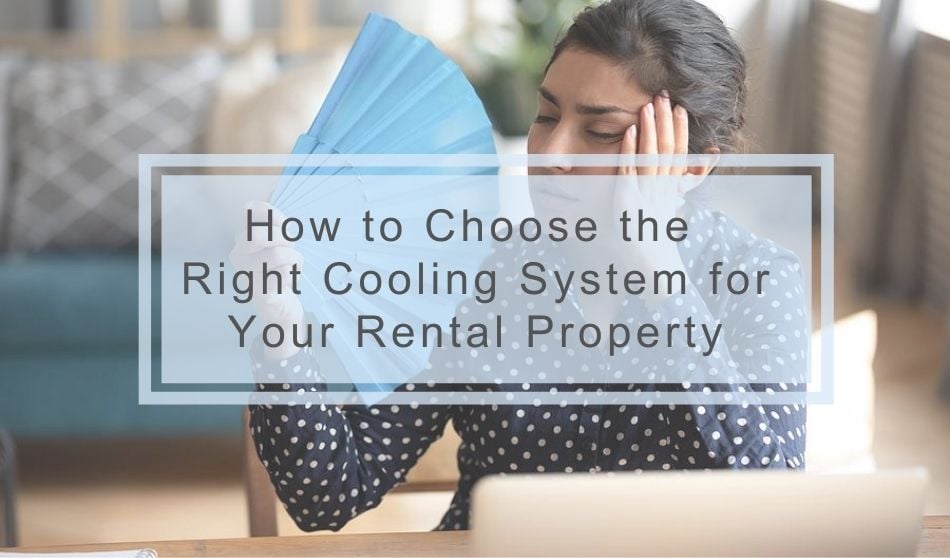
As spring weather heats up and with summer just around the corner, you may find yourself with the task of choosing a cooling system for your rental property. Whether you are selecting a cooling system for a newly built property or replacing the system in an existing property, it is important to know your options and pick the one that best fits your property’s needs.
Central Air Conditioning
Central AC comes with a few popular options that include:
- Split AC – This is the most popular cooling system; it uses the same ductwork as your heating system.
- Heat Pump – This system does double duty; it pumps heat out of your property to cool it in the summer and draws heat inside during the winter.
- Roof Top Unit – Another heat and cooling system, this one is great for multi-unit properties and can be installed on the roof or on the ground.
Before you can choose the right air conditioning system for your rental property, have a qualified and trained HVAC technician perform an energy audit. During an energy audit, the technician will perform a load calculation to determine system specs that will best fit the needs of your particular property. An HVAC contractor will also help you identify the most energy-efficient AC unit based on:
- Size
- Humidity extraction
- Environmentally friendly coolants
- Noise
Choosing the correct size cannot be overstated and is the most critical element for successful property cooling. Installing an improperly sized AC system leads to energy waste and can drive up energy bills for owners and tenants. It could also prompt the need for an AC system replacement much sooner than you should require.
Ductless Cooling
A ductless cooling system, also called a ductless mini-split air conditioner, consists of:
- An outdoor unit
- Indoor units located in each desired room
- Remote control(s)
Indoor and outdoor units are connected but can be up to 50 ft. apart. Each indoor unit can be controlled by remote to turn it on/off or adjust the temperature as needed. Indoor units can be freestanding, installed into a drop ceiling, or mounted high on the wall or ceiling of each room. These are great for multiunit or retrofitted properties where traditional central AC with ducts isn’t an option.
Geothermal Cooling
Geothermal cooling uses renewable energy heat from the ground below the Earth’s surface to cool and heat properties, making it one of the most eco-friendly cooling systems available. This cooling system presents the opportunity to reduce your carbon footprint and contribute to the efforts of combating climate change.
To install a geothermal cooling system, an HVAC contractor will:
- Dig wells
- Insert pipes or loops filled with a water solution underground
- Seal the loops
- Run pipes from the ground to the heat pump
Once the installation is complete the water solution will transfer the heat through the geothermal loops to and from your property as the season dictates. During hot weather, heat is removed from your property and transferred into the earth through a closed-loop system. When the weather turns cold, the geothermal heat pump will reverse the process, taking the heat stored within the earth and moving it into your residential or business property.
Whole House Fans
Whole house fans are most often used to supplement other cooling systems so that an AC unit does not need to run all night to keep the property cooled. They work by pulling cool air from outside into the building and forcing the hot inside air out through attic vents. Whole house fans are installed in a central hallway between the attic and the top floor of a residence to provide ventilation and cooling.
When choosing a whole house fan, have an HVAC contractor help you measure to make sure you have enough space and ventilation to accommodate one in your property. A technician will help you select the right size fan for your property based on:
- Square footage
- The kind of cooling effect you want (moderate airflow or more of a breeze)
Note: If you have a gas heater or a furnace with a standing pilot light, you cannot install a whole house fan due to the risk of fire.
Once installed and turned on, it will reduce the need for air conditioning. Your tenants can give the air conditioner a break by using the whole house fan when temperatures outside are cooler at night. The level of comfort will increase immediately as tenants will notice up to a 10-degree difference as soon as the whole house fan is turned on.
Attic Fans
Attic fans are sometimes confused with whole house fans. However, these are two different cooling systems with two different purposes. Attic fans ventilate and lower the temperature of your attic only, whereas whole house fans are cooling systems for the entire living space.
Attics can heat up – especially during the summer months – reaching temperatures as high as 160 degrees, which means the rooms closest to it get hotter too. Attic fans help mitigate this, ease the workload of your other cooling systems (like air conditioning), and extend the life of your roof.
In the event your AC goes out, though, attic fans can act as a backup to help keep your home from heating up too quickly and to keep you cooler until your trusted HVAC contractor can repair or replace your system.
Space is important when considering attic fan installation. Measure to make sure you have enough space and cross ventilation to accommodate an attic fan. Otherwise, you run the risk of pulling the air you have cooled for the living space up into the attic where you don’t need it.
Improving Your Property’s Indoor Air Quality
The Environmental Protection Agency (EPA) notes that indoor air can be 2 to 5 times more polluted than outdoor air. You can improve the Indoor Air Quality (IAQ) of your rental property with the following systems and services:
- Air duct cleaning – National Air Duct Cleaners Association (NADCA) recommends this service every 3 to 5 years.
- Dryer vent cleaning – In addition to cleaner air, FEMA notes that failing to clean these vents is a leading cause of fires in residential buildings
- Humidifiers – Colder months mean lower moisture levels. These units balance those levels helping to reduce dryer and itchy skin as well as a higher susceptibility to infections and colds.
- Air cleaners – These units work to remove fine particulates that are known to trigger allergies, asthma, and respiratory distress.
- Air scrubbers – Using a portable filtration system, these units trap, reduce and remove contaminants from the air and even on many surfaces, lower the bacteria and pathogen levels that may contribute to allergies, colds, and viruses.
These systems and services remove pollen and other pollutants from the air of your rental property; and thereby improve the IAQ. Cleaner air means lower risk for or exacerbation of asthma and allergies. These systems can also reduce the risks of mold, mildew, and airborne viruses.
Top Factors in Choosing Your Cooling System
As you consider options to keep your property cool, you’ll need to weigh your priorities with regard to installation costs, desire for renewable and eco-friendly systems, rebates and incentives offered and the operations costs — all which will directly affect your monthly energy bill. With these in mind, call upon experienced HVAC contractors who are well versed in the most popular cooling systems and brands available and can help assess the very best fit for you and your property.





